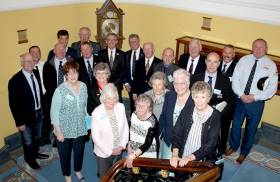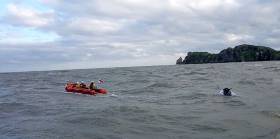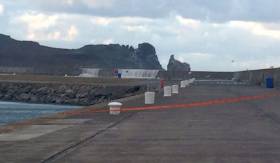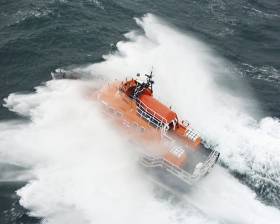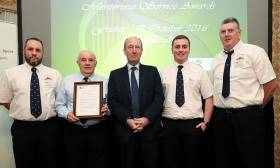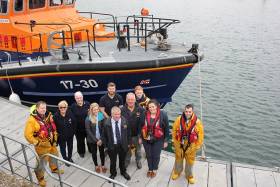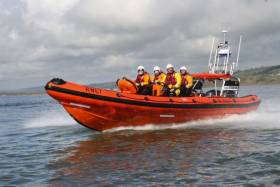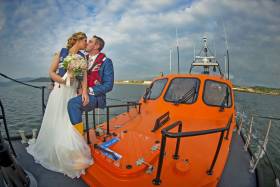Displaying items by tag: RNLI
RNLI Honours 21 Volunteers at Annual Awards Ceremony
RNLI volunteers have been honoured at the charity’s annual presentation of awards in Northern Ireland.
The event which was staged at the Belfast Harbour Commissioner’s Office on Friday night (21 October) honoured 21 awardees recognising their dedication and commitment to volunteering over long periods of time in a bid to raise funds and awareness and to help save lives at sea.
The ceremony was opened by Christopher Brooke, a member of the RNLI Council of Ireland. Mr Brooke welcomed the awardees and their families before introducing the guest speaker, outgoing RNLI Chairman Charles Hunter-Pease.
The awards included eight Gold Badges, four Bar to Gold badges, one supporter award, two Honorary Life Governorships and six long service awards.
The eight gold badge awards which recognise those who have dedicated many years to supporting the RNLI, were awarded to Sean Boyle and James Shovlin from The Rosses Branch in County Donegal, Rodney Byrne and Dorothy Weeks from the Portrush Lifeboat Management Group, Patrick Carter and Martin Reilly from the Sligo Bay Branch, Paddy McLaughlin from the Red Bay Branch in Cushendall and Lillian Stewart from the Larne Branch.
The Adelphi Hotel in Portrush was recognised with a supporter award.
There were four Bar to Gold badges, one of which was awarded posthumously to John Charleton from the Kilkeel Branch. Lynda Davidson from the Donaghadee Fundraising Branch, Margaret Nicholson from the Kilkeel Branch and Aileen Smyth from the Donaghadee Ladies’ Guild were also awarded.
The Honorary Life Governorship awards went to Eveleigh Brownlow from Portaferry and District Guild and Elenore Huston from the Coleraine/Castlerock Branch.
The long service awards in recognition of 20 years volunteering commitment went to Jeffrey Bell from Larne RNLI, Gregory McDaid from Lough Swilly RNLI, Raymond Newell from Kilkeel RNLI and Simon Rogers from Portaferry RNLI. Morrris McBride from Kilkeel RNLI and Shane McNamara from Donaghadee RNLI were recognised with a 30 year Bar to Long Service badge.
Speaking at the ceremony, Mr Hunter-Pease said there were a range of differing reasons why people volunteered for the RNLI: ‘There are the friendships forged through a common lifesaving aim. The thrill of seeing visitors enjoying your carefully planned events. The weight of a heavy bucket after a hard day’s collecting. And, yes many are motivated to volunteer for us by the pain of losing a loved one to the sea. They have converted that loss into a determination to make a difference to the lives of others.’
He said it was truly humbling to think of the collective years’ experience and care that was in the room: ‘To everyone one of you receiving an award – whether your service has been at sea or ashore – wear it with pride. It is the mark of someone very special, selflessly dedicated to the lives of others.’
Before presenting the awards, Mr Hunter-Pease said the RNLI had made an extraordinary difference to people’s lives in 2015. Volunteers from Northern Ireland’s nine lifeboat stations rescued 279 people and saved 11 lives. The lifeguards on 11 beaches on the Causeway Coast and in County Down rescued 11 people and saved one person’s life.
Howth RNLI Rescues Man From Sea after Jet Ski Gets into Difficulty
Howth RNLI rescued a man who got into difficulty on a jet ski this afternoon and ended up in the water east of Ireland’s Eye.
The volunteer lifeboat crew was requested to launch both their inshore and all-weather lifeboats at 3.35pm following reports that a man was missing in the sea after his jet ski developed engine difficulties.
The alarm had been raised by a companion of the casualty’s who had come ashore on his own jet ski.
The two men had left Howth harbour earlier in the day before one of their jet skis encountered problems.
The lifeboats quickly travelled to the reported area between Balscadden and Ireland’s Eye and commenced a search.
Weather conditions at the time were described as good with clear visibility. However, the sea was quite rough with strong easterly winds generating large breaking waves in the vicinity of Ireland’s Eye.
As Afloat.ie reported earlier, the Irish Coast Guard helicopter Rescue 116 was also tasked to the search. Using its onboard search equipment, the helicopter quickly located the casualty who had drifted quite a distance from his original location.
Following this communication from the Coast Guard helicopter, the all-weather lifeboat proceeded to the scene and rescued the casualty who was found clinging to the jet ski. He had been in the water for approximately 30 minutes. Once onboard the lifeboat, the crew began to administer casualty care to man who was extremely cold.
Arriving back at Howth Lifeboat Station, the man was transferred from the lifeboat into a waiting ambulance where he was treated for hypothermia.
The inshore lifeboat meanwhile took the stricken jet ski in tow and returned it to the safety of Howth Harbour.
Speaking following the call out, Colm Newport, Howth RNLI Lifeboat Operations Manager said: ‘Time was of the essence this afternoon as the casualty was in the water for some time. Team work was at the centre of this call out and with thanks to our colleagues in the Irish Coast Guard who located the casualty once onscene, we were able to rescue the man and bring him ashore. We would like to wish both him and his companion well following their ordeal.’
This afternoon at 3.30pm the Irish Coast Guard emergency operations centre in Dublin received a call reporting a missing jet skier. The Coast Guard team in Howth, Coast Guard Rescue 116 Helicopter and the Howth RNLI lifeboats were immediately tasked.
Search teams combed the water and coastline. About 30 minutes later the Coast Guard Helicopter located the jet skier with his submerged craft North of Ireland's Eye. The Howth lifeboats brought the casualty back to shore to a waiting ambulance. The jet skier who was wearing a Life Jacket didn't have serious injuries.
During the rescue a sighting of someone possibly in the water off Balscaden was reported. Rescue teams were again dispatched and after a search nothing was located.
Finally as teams were wrapping up it was noted that waves were breaking on the East Pier in Howth with people out walking in danger of getting washed over by breaking waves. A Coast Guard team spoke to members of the public and advised them against walking down the pier until after the weather conditions passed, one person was assisted back to safety from beyond the breaking waves. Coast Guard personnel maintained a position on the pier until the high tide receded.
Canadian Yacht with Two Onboard Rescued By Arranmore RNLI
Arranmore RNLI in County Donegal launched in the early hours of this morning (Wednesday 19 October) to go the assistance of two sailors who got into difficulty at St John’s Point.
The volunteer lifeboat crew was requested to launch their all-weather lifeboat at 4.15am at the request of the Irish Coast Guard following a report that a Canadian 45ft yacht with two men onboard had ran aground at St John’s Point.
The lifeboat under Coxswain Lee Early and with six crew onboard launched and made its way to the scene.
Killybegs Coast Guard unit was also tasked.
Weather conditions at the time were described as blowing a Force 4-5 north westerly wind with a two metre swell.
Once on scene at 6.20am, the lifeboat crew observed that the vessel was right up on the reefs making it difficult for the Coast Guard’s inshore boat and the RNLI’s all-weather lifeboat to get close to the casualties. The yacht had also begun to take on water. It was at this point the Irish Coast Guard helicopter Rescue 118 from Sligo was also tasked with the decision made to airlift the sailors to safety.
Speaking following the call out, Arranmore RNLI mechanic Philip McCauley said: ‘This was a challenging call out for ourselves and our colleagues in the Coast Guard this morning due to where the vessel had ran aground so close to the rocks. We were able to assist the helicopter with providing extra light in the darkness as it winched the sailors to safety. We would like to wish them both well following their ordeal.’
Seascapes Podcast: Des Brannigan, Crosshaven RNLI & Cork Sail Training Bursary Scheme
Hello and welcome aboard this week’s edition of Seascapes, your maritime programme, this week we remember diver, seafarer and trade unionist Des Brannigan ; we hear from Ron Coveney at the naming ceremony of a new Atlantic 85 lifeboat to Crosshaven RNLI Station – “John and Janet” which took place early last month ; Bow Tie Day and Migrant Offshore Aid Station celebrating their 2nd Anniversary and how you can get involved ; plus a special night in Midleton celebrating Edward Bransfield from Ballinacurra with author Michael Smith and news of the Annual Shackleton Dinner planned for Cobh this year on the 22nd of December ; we have special First Day Covers Irish Lights stamps and Prestige booklets recently issued by An Post in a special presentation pack for Seascapes listeners in our competition ................. first on Seascapes this week to the recent presentation by Sail Training Ireland and the Port of Cork as part of the Cork Sail Training Bursary scheme for this year , vessels used were “Morgenster” and “The Spirit of Oysterhaven “ also in attendance on the day was Seamus McLoughlin , Chairman of Sail Training Ireland; Commodore Hugh Tully, Flag Officer Commanding the Naval Service ; Brendan Keating , CEO of The Port of Cork ,and outgoing manager of Sail Traing Ireland the genial Michael Byrne.... first we hear from Youth Officer aboard the Spirit of Oysterhaven Aoibh Deane ........
From Aoibh Deane, Youth Officer to Oliver Harte ......
The voice there of Oliver Harte of the Spirit of Oysterhaven.....
The Cork Sail Training Bursary Scheme is supported by Cork City Council; Cork County Council ; National Maritime College of Ireland; Ardmore Shipping ; Irish Institute of Master Mariners and EMC2 , on Friday 28th of this month we’d like you to wear a bow tie to work to mark the 2nd Anniversary of Migrant Offshore Aid Station and spread awareness of the work the they do in the Mediterranean , you can see and read more on the Seascapes webpage........this initiative is being supported by Provision Photography / House of AKI-NA /Sail Training Ireland and yours truly...you can read and see more on facebook
A new Atlantic 85 lifeboat for Crosshaven RNLI named John and Janet was launched early last month in Crosshaven, The new lifeboat, an Atlantic 85 is the latest version of the B class, introduced into the fleet in 2005. She is powered by two 115horsepower engines and has a stronger hull and greater top speed than her predecessor. The added radar allows the crew to operate more effectively in poor visibility and she also has VHF direction-finding equipment. Lets hear from Conor Curtin , Divisional Operations Manager with the Royal National Lifeboat Institution ...
The lifeboat which went on service in June this year was funded by an anonymous donor. Irish marine journalist and broadcaster Tom MacSweeney represented the donor at the naming ceremony and service of dedication and handed the lifeboat into the care of the RNLI.Ron Coveney spoke to Tom at the ceremony .....
The lifeboat was named by young Paddy Crowley, son of the late Con, a long serving and much loved helm at Crosshaven RNLI who died suddenly last year.
In 2015, Crosshaven RNLI launched 42 times and rescued 50 people. The new lifeboat replaces Miss Betty, the station’s first permanent lifeboat, which was on service in Crosshaven since the station was formally established 14 years ago. Lets hear from , Patsy Fegan, Crosshaven RNLI Lifeboat Operations Manager
A word next from helmsman Paddy Quinlan ....
Thanks to ace reporter Ron Coveney who attended that naming ceremony at Crosshaven RNLI Station of the new Atlantic 85 Lifeboat launched early last month .......
The Ernest Shackleton Autumn School will run from the 28th October to the 31st October at the Athy Heritage Centre / Shackleton Museum in his home county featuring a
Wide range of speakers on a diverse set of related topics ........
Distinguished Polar Author Michael Smith is due to give a talk hosted by Cloyne Literary and Historical Society on Edward Bransfield (1785 to 1852) of Ballinacurra in the Midleton Park Hotel on Tuesday 25th October commencing at 8pm, admission is €5 euro.
Speaking of Shackleton the Annual Shackleton Dinner takes place on the Thursday 22nd of December , this year the venue is in Cobh at The Sirius Centre , more detail from John O Reilly who may be contacted on
BBC CO SIG
Jim Rees writes to let us know that Arklow Maritime Museum's new website is up and running.
Castletownbere RNLI Presented with National Marine Gallantry and Meritorious Service Award
The volunteer lifeboat crew from Castletownbere RNLI has been awarded a Marine Ministerial Letter of Appreciation for Meritorious Service.
The award in recognition of the crew’s ability to locate and save a life in challenging weather conditions was presented by the Minister for Transport, Tourism & Sport Shane Ross, T.D. at the National Marine Gallantry and Meritorious Service Awards 2016 at a ceremony in Farmleigh House in the Phoenix Park on Friday evening (14 October).
Castletownbere RNLI was represented at the awards by Lifeboat Operations Manager Tony O’Sullivan, Coxswain Brian O’Driscoll and crew members John Paul Downey and Kyle Cronin.
The call out for which the lifeboat was awarded happened when the Castletownbere lifeboat, Annette Hutton, was launched early on Saturday morning 20 August. After 12 hours at sea in storm force conditions, the volunteer lifeboat crew rescued a lone sailor.
Valentia Coast Guard Radio had requested assistance to a yacht in difficulties 45 miles south of Mizen head in West Cork. The resceu was reported at the time by Afloat.ie here.
The eight-metre yacht, with one person on board, had left the Azores in early August and ran into difficulties the day previous. The sailor, in his sixties, had been in regular radio contact with Valentia Coast Guard radio until the morning when his VHF radio was washed overboard. He activated an EPIRB to identify his location, raise the alarm and seek help.
The lifeboat, under the command of Coxswain Brian O’Driscoll, was launched at 8am and located the casualty at 10.40am 50 miles south-west of Castletownbere. The Irish Coast Guard helicopter was also on scene.
Conditions were described as gusting Force 8/9 winds with a 30 foot swell. The yacht was taken under tow and the lifeboat proceeded slowly to Castletownbere in challenging sea conditions. Early into the tow lifeboat crew became concerned about the wellbeing of the sailor and crew managed to transfer him to the lifeboat. The lifeboat, with the damaged yacht in tow, returned to Castletownbere at 8.30pm having been at sea for 12 and a half hours.
Later that evening the sailor thanked the Castletownbere lifeboat and all involved for ‘saving his life’. He said: ‘only for the lifeboat, things would have ended up very badly today’.
The Castletownbere Coxswain and crew demonstrated skill, seamanship and endurance during what was a long and challenging day.
Speaking at the awards ceremony, Minister Ross praised the ‘courageous achievements and service of this group of brave Irish men and women who have faced crises and dug deep, offering their skills and in many cases placing themselves in danger in order that others might be safe on our waterways’.
Pausing to remember those who lost their lives at sea since the last set of Awards in 2014, Minister Ross spoke of the tragic death of volunteer Coast Guard Caitríona Lucas last month, describing her as ‘a courageous and heroic woman who made the ultimate sacrifice while in the service of others’.
The awards are to recognise outstanding acts of courage, heroism, skill and initiative in the context of marine emergency incidents. The scheme also recognises exceptional dedication to duty in the execution of Ireland’s marine emergency response.
A Marine Ministerial Letter of Appreciation may be awarded for meritorious service where outstanding dedication to duty over a career of service can be demonstrated, or for an act of particular meritorious dedication, showing skill and initiative, but which is not of an order for receipt of a Meritorious Service or Marine Gallantry medal.
The volunteer lifeboat crew from Kinsale RNLI and Lough Swilly RNLI in County Donegal were also awarded a Marine Ministerial Letter of Appreciation.
The National Marine Gallantry and Meritorious Service Awards Committee is chaired by Bryan Dobson of RTÉ.
UK Justice Minister Visits Portrush RNLI Volunteers
Claire Sugden, The Justice Minister called in on her local RNLI Lifeboat station at Portrush the weekend to pay tribute to the work they do on the North Coast.
The Minister was keen to meet all the volunteers including crew, fundraisers and the operations team. She met Des Austin, Cox and Robin Cardwell Lifeboat Operations Manager (LOM) in the lifeboat House firstly to hear about the work of the volunteers and the rigorous training they underwent in order to achieve the competencies to be able to save lives at sea. She then met Sharman Finlay Chair of the fundraising team and Dorothy Weeks, supervisor of the very successful Lifeboat Shop to hear about the importance of fundraising activities to support the volunteer crew.
The Minister then met the volunteer crew of the Inshore Lifeboat and then went on board the All-weather Boat to get a tour of the boat and then experienced a launch as the crew took her out of the bay so she could see for herself, what the crew experienced when they went out on a shout.
The team at the station were delighted to meet the Minister and to have the chance to explain first-hand the importance of the work they do and the training that goes on behind the scenes.
Robin Cardwell LOM said
‘We were delighted to welcome the Minister to her local station and to give her an opportunity to see for herself the operations of a busy lifeboat station. We were thrilled that we had the opportunity to see the ALB in action to have a chat with the volunteer crew, operations team and fundraisers’.
The Minister said in a statement
‘The RNLI provides an invaluable service in keeping the public safe around our coastline. The men and women who volunteer to answer emergency calls in all weathers have helped save countless lives and I commend them for their dedication and commitment.
“The RNLI aims to reduce drowning by 50%, across the UK and Ireland by 2024. Given the dedication and enthusiasm I have seen demonstrated by the Portrush crew, I am confident that they will succeed.”
Youghal Lifeboat Launches To Man Taken Ill On Angling Boat
#RNLI - Youghal RNLI’s volunteer lifeboat crew were tasked yesterday morning (Saturday 15 October) in choppy waters to reports of a man taken ill on board a chartered angling vessel.
At 11.30am the lifeboat launched to the location around a mile and a half off Capel Island, where the casualty had been unconscious for a period and was pale in appearance.
The lifeboat crew proceeded to administer casualty care when they recovered the casualty on board.
An ambulance was also requested and was awaiting the lifeboat on its return to station, where the paramedics checked the casualty over before giving him the all clear.
Commenting on the callout, Youghal RNLI lifeboat Helm John Griffin said: “[The charter vessel operators] did the right thing in contacting us when the man became unwell.
“It’s always better to get an ill person medically checked out if there are any concerns.”
Lough Swilly RNLI Groom’s Wedding Speech Interrupted By Lifeboat Launch
#RNLI - Buncrana man Francy Burns wed his sweetheart, Carndonagh woman Helen McFarland, last Saturday 8 October in a wedding attended by their family, friends and the volunteers with Lough Swilly RNLI.
But it wasn’t all plain sailing, as after the vows were exchanged and Francy took the microphone to make his wedding speech, the lifeboat pagers went off and the volunteer lifeboat crew jumped to their feet and raced out of the room to the callout.
The incident was a reminder to Helen of what she can expect married to a lifeboat volunteer.
However, as Francy was preparing to follow his lifeboat colleagues and head out the door to the callout, the coxswain assured him they had enough crew and he could stay where he was and enjoy the day.
The callout was to a vessel with one person on board which had lost engine power and had been drifting for three hours.
Lough Swilly RNLI launched their new Shannon-class lifeboat and brought the vessel to safety, with the lifeboat crew returning to the wedding reception some hours later.
As the wedding reception was held in the Gateway Hotel, Francy had the perfect view out the window down on the berth from where the lifeboat is launched.
“It was certainly a day of mixed emotions,” said Francy. “I married the most beautiful and amazing woman but when I saw the crew stand up to head out for the lifeboat shout during my speech my first thoughts were to follow them.
“You never know what you are launching to but thankfully it was fairly straightforward. Helen understands how I feel about the lifeboat and she is fully supportive. You never know, I might even persuade her to sign up too.”
Lough Swilly lifeboat volunteer crew member and press officer Joe Joyce added: “The launch sort of added to the whole day. You couldn’t have planned it better.
“Everyone with Lough Swilly RNLI wish Francy and Helen every happiness on their marriage and we will see Francy down at the station for our next shout.”
Courtmacsherry RNLI Lifeboat Rescues 40–foot Sailing Sloop off Kinsale
The Courtmacsherry RNLI All Weather Lifeboat was called out at 12.30pm this afternoon to go to the aid of a 40–foot Sailing Sloop 'in trouble' eight miles off the Old Head of Kinsale in West Cork.
Coxswain Sean O'Farrell and a crew of six launched in response to the Mayday alert from Coastguard and reached the casuality at 1.10 pm. The casualty with two persons on board had lost power in deteriorating conditions at sea and one of the crew person on board the yacht was also reported unwell.
The lifeboat succeeded in transferring its tow rope in difficult conditions to the casualty which was on passage from England to West Cork.
The Lifeboat took the vessel in tow and is heading at low speed to Kinsale.
Conditions at sea this afternoon are very poor with strong winds force 7/8 with very heavy swells. Winds in the area are blowing 35–knots and increasing.
The estimated time of arrival in Kinsale is approx 2.45pm
The RNLI crew are Coxswain Sean O Farrell and volunteer crew members Tadgh McCarthy (Mechanic), Mark Gannon, Ciaran Hurley, Ken Cashman, Mark John Gannon and Dave Philips.


























